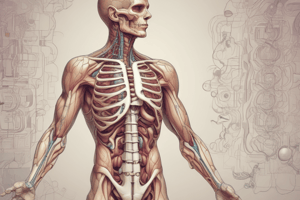Podcast
Questions and Answers
At which level does the rectum begin?
At which level does the rectum begin?
- S3 (correct)
- S2
- S1
- S4
Where is the liver primarily located?
Where is the liver primarily located?
- Right hypochondrium and epigastric region (correct)
- Left epigastric region
- Right hypochondrium
- Left hypochondrium
How many surfaces does the liver have?
How many surfaces does the liver have?
- 2 (correct)
- 3
- 5
- 4
Where is the gallbladder located?
Where is the gallbladder located?
What is the shape of the gallbladder?
What is the shape of the gallbladder?
Where is the pancreas located?
Where is the pancreas located?
How many parts does the pancreas consist of?
How many parts does the pancreas consist of?
Where is the head of the pancreas located?
Where is the head of the pancreas located?
What is the region where the pancreas extends from the right to the left?
What is the region where the pancreas extends from the right to the left?
Which structures does the pancreas extend between?
Which structures does the pancreas extend between?
Flashcards are hidden until you start studying
Study Notes
Digestive System
- Consists of oral cavity, pharynx, esophagus, stomach, small and large intestine, liver, and gallbladder, and pancreas.
Oral Cavity
- Located inferior to nasal cavities
- Has roof, floor, and lateral walls
- Opens onto face through the oral fissure
- Continuous with pharynx at the oropharyngeal isthmus
Tongue
- Muscular structure forming part of floor of oral cavity and anterior wall of oropharynx
Pharynx
- Musculo-fascial tube extending from base of skull to esophagus
- Pharyngeal cavity is a common pathway for air and food
- Attached above to base of skull and continuous below with esophagus at approximately vertebra CVI
- Subdivided into nasopharynx, oropharynx, and laryngopharynx
Esophagus
- Muscular tube passing between pharynx in neck and stomach in abdomen
- 20-25 cm long and above level of umbilicus
- Lumen is the widest of small intestine
Small Intestine
- Consists of duodenum, jejunum, and ileum
Duodenum
- Divided into four parts
- First part: extends from pyloric orifice of stomach to neck of gallbladder
- Second part: extends from neck of gallbladder to lower border of vertebra LIII
- Third part: crosses inferior vena cava, aorta, and vertebral column
- Fourth part: passes upward and terminates at duodenojejunal flexure
Jejunum
- Proximal two-fifths of small intestine
- Larger in diameter and thicker-walled than ileum
- Inner mucosal lining characterized by numerous prominent folds (plicae circulares)
- Arterial supply includes jejunal arteries from superior mesenteric artery
Ileum
- Distal three-fifths of small intestine
- Thinner-walled and fewer mucosal folds than jejunum
- Opens into large intestine where cecum and ascending colon join
- Arterial supply from superior mesenteric artery
Large Intestine
- Begins at ileocecal junction and ends at anal orifice
Caecum
- Large blind pouch lying in right iliac fossa
- Continuous superiorly with ascending colon
- Ileocecal valve formed of two segments: upper and lower
Vermiform Appendix
- Narrow tube arising from posteromedial caecal wall
- May occupy one of several positions: retrocaecal, retrocolic, pelvic, descending, subcaecal, preilial, or postileal
Ascending Colon
- 15 cm long and narrower than caecum
- Ascends to inferior surface of right lobe of liver
- Turns sharply forward and to left at hepatic flexure
Transverse Colon
- 50 cm long
- Extends from hepatic flexure to left hypochondriac region
- Curves posteroinferiorly below spleen as splenic flexure
Descending Colon
- 25 cm long
- Descends through left lumbar and hypochondriac regions
- Curves inferomedially to become sigmoid colon at inlet of lesser pelvis
Sigmoid Colon
- Begins at pelvic inlet and ends at rectum
- Sigmoid loop ends just to left of midline at level of third sacral body
Rectum
- Most distal segment of large intestine
- Continuous proximally with sigmoid colon and terminates into anal canal
- Begins at level of S3
Liver
- Largest visceral organ in body
- Primarily in right hypochondrium and epigastric region, extending into left hypochondrium
- Surfaces include diaphragmatic and visceral surfaces
Gallbladder
- Pear-shaped sac lying on visceral surface of right lobe of liver in a fossa between right and quadrate lobes
Pancreas
- Lies mostly posterior to stomach
- Extends across posterior abdominal wall from duodenum on the right to spleen on the left
- Consists of head, uncinate process, neck, body, and tail
- Head of pancreas lies within C-shaped concavity of duodenum
Studying That Suits You
Use AI to generate personalized quizzes and flashcards to suit your learning preferences.




